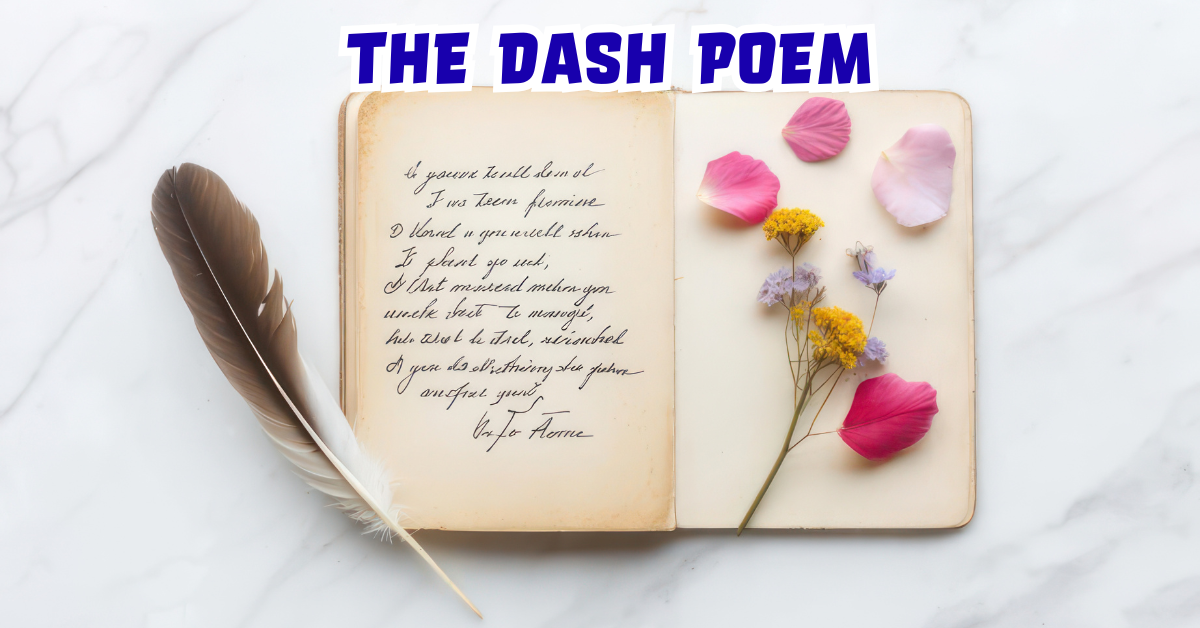When people reflect on their lives, they often think about milestones — the day they were born and the day they will leave this world. Yet between those two dates lies a small line — a dash — that quietly carries the entire story of one’s existence. “The Dash”, a poem written by Linda Ellis in 1996, beautifully captures this concept, reminding us that what truly matters is not the dates etched on our tombstones, but the life we live in between. Within just a few lines, the poem distills profound wisdom about love, compassion, legacy, and purpose — urging us to live intentionally, not just exist.
In this article, we’ll explore the message, symbolism, and cultural resonance of The Dash poem. You’ll learn how this short, reflective piece continues to touch lives decades after its creation, becoming a universal reflection on how we measure the worth of a human life.
Origin and Background of The Dash Poem
Linda Ellis wrote “The Dash” in 1996, and within months, it began circulating widely through email forwards and word of mouth — long before social media made things go viral. The poem was inspired by a simple thought: what defines the value of a person’s life?
Ellis was reportedly inspired by a eulogy that referenced the importance of the dash between birth and death dates. Her poem resonated deeply with readers from all walks of life — from clergy to corporate leaders, from educators to grieving families. Over time, The Dash evolved from a simple verse into a movement that encourages people to reflect on how they live, love, and contribute to the world.
What makes The Dash so compelling is its accessibility. It speaks in plain language, yet its message is layered with spiritual and emotional complexity.
The Meaning Behind “The Dash”
At its heart, The Dash symbolizes the sum of our life’s experiences — not the years we live but how we live those years. The poem encourages mindfulness: each decision, word, and act adds meaning to our dash.
The dash represents relationships, kindness, courage, forgiveness, and integrity. It’s about taking the time to connect with others, appreciate small joys, and live authentically rather than being consumed by material pursuits or societal validation.
In the first few lines, Ellis captures a timeless truth — that when people look back on our lives, they won’t focus on our possessions, achievements, or titles, but on how we treated others and the legacy we left behind.
The Emotional Resonance and Why It Endures
Decades after its publication, The Dash continues to appear in memorials, motivational speeches, and classrooms worldwide. Why? Because it speaks to something universal — the human longing for meaning.
In a world obsessed with speed and success, The Dash invites stillness. It asks us to pause and think about whether our daily choices align with the kind of person we want to be remembered as. It’s both a comfort to the grieving and a wake-up call to the living.
The poem’s tone — simple yet profound — makes it relatable to people across faiths, cultures, and generations.
The Poem’s Core Themes and Symbolism
Let’s look deeper into the layers of meaning that make The Dash so timeless.
| Theme | Description |
|---|---|
| Time | Life is finite; the dash symbolizes the limited space between our beginning and end. |
| Legacy | True value lies in the impact we leave on others, not material possessions. |
| Mindfulness | Living in the moment gives purpose to our dash. |
| Empathy and Kindness | Our relationships define our existence more than our achievements. |
| Reflection and Change | The poem invites self-assessment and transformation. |
Each theme flows seamlessly into the next, forming a blueprint for intentional living — a life that prioritizes meaning over mere existence.
Lessons from The Dash: Living a Purposeful Life
The poem is more than a reflection; it’s a guidepost for action. It challenges us to ask difficult questions:
- Are we living according to our values?
- Do our daily choices reflect love, kindness, and integrity?
- How do we want to be remembered when our dash ends?
Ellis encourages readers to slow down, appreciate the present, and find joy in the small acts of humanity. Living purposefully means recognizing that every moment — even mundane ones — shapes the story of our dash.
The Dash and Modern Society
In the digital age, people often measure life by numbers — followers, likes, or accomplishments. The Dash challenges that mindset. It reminds us that fulfillment cannot be quantified.
In workplaces, the poem is frequently used in leadership training to emphasize emotional intelligence and compassion. In education, it’s used to inspire students to pursue purpose over perfection.
It stands as a counter-narrative to a culture that glorifies busyness. The poem whispers a truth: it’s not how fast you run, but how deeply you live.
The Dash in Funeral Readings and Life Celebrations
The Dash has become one of the most widely recited poems at funerals and memorial services. Its message offers solace — transforming grief into gratitude.
When someone passes away, their dash becomes a symbol of their story — a story written in love, laughter, and sacrifice. Families often find comfort in reflecting on how their loved one “spent their dash.”
More than remembrance, the poem encourages the living to carry forward that legacy by living with compassion and authenticity.
The Dash’s Connection with Mindfulness and Gratitude
The poem aligns closely with mindfulness philosophy — the idea that awareness of the present moment is key to a fulfilling life.
When Ellis speaks of “making the most of your dash,” she calls for gratitude in everyday experiences. It’s about noticing life’s subtleties: a conversation with a friend, the beauty of nature, or moments of silence.
Gratitude transforms the ordinary into the extraordinary. It teaches us that meaning isn’t found in future goals but in present awareness.
Literary Devices and Tone in The Dash
Despite its simplicity, The Dash employs several literary techniques that enhance its emotional power.
| Device | Description |
|---|---|
| Metaphor | The dash symbolizes an entire lifetime. |
| Contrast | The brevity of the dash contrasts with the richness of life it represents. |
| Alliteration | Gentle rhythm enhances readability and emotional flow. |
| Imagery | Readers visualize the tombstone, creating a vivid connection with mortality. |
| Tone | Reflective, compassionate, and motivational. |
These stylistic elements make the poem feel personal, as if Ellis is speaking directly to the reader — not preaching, but inviting quiet introspection.
The Dash’s Legacy in the Digital Era
Nearly thirty years after its creation, The Dash continues to find new life online. Short clips of the poem are used in motivational videos, and its verses appear on social media as reminders to live meaningfully.
Organizations and life coaches have adopted the poem’s philosophy in workshops, therapy, and even corporate ethics training. It’s proof that the digital world, despite its chaos, still hungers for human connection and depth.
In essence, The Dash has transcended poetry — becoming a philosophy for mindful existence.
5 Common Misinterpretations of The Dash
While the poem’s message seems straightforward, its depth often leads to varied interpretations. Here are common misconceptions:
| Misinterpretation | Clarification |
|---|---|
| It’s only about death | It’s more about how we live than how we die. |
| It’s religious | The message is universal and not tied to any specific faith. |
| It’s about career success | It values emotional and spiritual fulfillment over material gain. |
| It’s sentimental nostalgia | It’s a call to conscious action, not mere reflection. |
| It’s meant only for funerals | It’s also used for personal growth, education, and leadership. |
Understanding these clarifies why The Dash remains timeless — it appeals to everyone, no matter their beliefs or life stage.
How to Live Your Own “Dash” Consciously
So how can you make your dash count? Here are practical reflections drawn from the poem’s philosophy:
| Step | Practice | Purpose |
|---|---|---|
| 1 | Practice daily gratitude | Ground yourself in the present and value small joys. |
| 2 | Build meaningful connections | Strengthen empathy and create lasting bonds. |
| 3 | Live authentically | Align your actions with your true values. |
| 4 | Forgive often | Release resentment to find inner peace. |
| 5 | Give generously | Your time and kindness enrich others’ lives. |
| 6 | Reflect regularly | Evaluate whether your actions match your principles. |
| 7 | Balance ambition with contentment | Strive for growth, not perfection. |
Living consciously means acknowledging that life is fleeting — and that every act, word, and choice adds to the story of our dash.
Frequently Asked Questions
1. Who wrote The Dash poem?
Linda Ellis wrote The Dash in 1996. The poem quickly gained global attention for its timeless message about living meaningfully between the dates of birth and death.
2. What is the main message of The Dash?
The poem teaches that what truly defines us is how we live — the love, kindness, and integrity we show — not our accomplishments or possessions.
3. Why is The Dash often read at funerals?
It provides comfort to the grieving by highlighting that a person’s life is measured by their compassion and impact, not by their lifespan alone.
4. How can The Dash inspire daily living?
By encouraging mindfulness, gratitude, and purpose-driven actions, it helps individuals focus on what genuinely matters in life.
5. Is The Dash considered religious or spiritual?
While it carries a reflective and spiritual tone, the poem’s message is universal and resonates with people of all beliefs.
Conclusion
The Dash is more than a poem — it’s a philosophy that bridges life and legacy. In its quiet simplicity, it reminds us that meaning is not found in grand gestures but in the love, compassion, and presence we bring to each day.
The poem asks us to slow down, live with intention, and appreciate the beauty of existence. It reminds us that one day, when others reflect on our lives, it won’t be the years that matter — but how we spent our dash.
In the end, The Dash isn’t about death; it’s about living fully. It’s a call to create a story worth remembering — a story that reflects kindness, courage, and authenticity.
As Linda Ellis so gently taught us: “What matters most is how we live and love, and how we spend our dash.”











